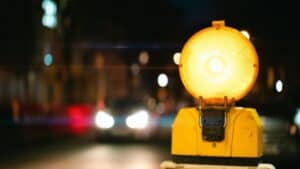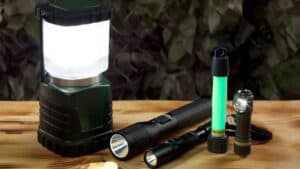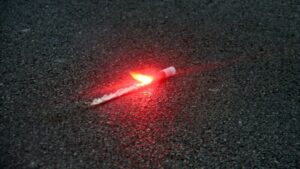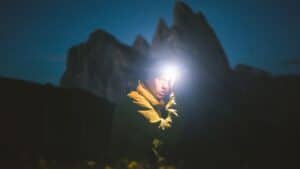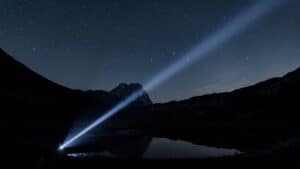When someone picks up a flashlight, they expect it to illuminate their surroundings, but not all flashlights perform the same way. The key difference lies in how the light beam is distributed and projected.
Long throw flashlights produce narrow, concentrated beams that reach great distances, while flood flashlights create wide-angle spreads of light that illuminate broad areas nearby. This fundamental distinction affects everything from the reflector design to the practical applications each type serves best.
In this guide you’ll learn the technical differences, real-world trade-offs, and how to pick the right light for specific scenarios.
*If you don’t have time to read the whole guide, contact us directly to discuss your needs and get a tailored recommendation.
Quick Comparison Snapshot
| Long-throw | Flood | |
| Purpose | illuminate distant objects; focused hotspot | illuminate wide areas close to you; broad spill |
| Best for | hunting, security, search & rescue, signaling | camping, close work, photography fill, maintenance |
| Typical measurement emphasis | candela / beam distance | lumens / beam angle and lux on nearby surfaces |
What is a Long-Throw Flashlight?
A long-throw flashlight (often called a “throw” light) projects light in a narrow, concentrated beam that travels significant distances. These flashlights focus their output into a tight spotlight rather than spreading it wide.
The beam typically reaches 1000 feet or more depending on the model. This extended range makes them ideal for outdoor activities and security applications.
Key Characteristics of Throw Flashlights Include:
- Narrow beam angle (usually 10-30 degrees)
- Concentrated hotspot with minimal spill light
- Deep reflector or specialized lens system
- High candela output for maximum distance
The design prioritizes distance over width. Engineers achieve this by using deep parabolic reflectors or precision optics that gather and focus the LED’s light into a tight beam.
Common Applications Include:
| Use Case | Benefit |
| Search and rescue | Spot objects from far distances |
| Security patrols | Illuminate distant areas |
| Hunting | Track wildlife without getting close |
| Marine navigation | Signal across water |
The narrow beam creates a bright hotspot surrounded by minimal spill light. This concentrated approach means users can see specific objects clearly at long distances.
However, the focused design creates limitations. The narrow beam provides limited peripheral vision and works poorly for close-range tasks requiring wide illumination.
Most throw flashlights use high-powered LEDs combined with smooth reflectors. The reflector depth and shape determine how tightly the light focuses and how far it travels.
Factors to Choose the Best Long Throw Flashlights
The reflector determines how far a flashlight can project its beam. Larger reflectors with smooth surfaces create better throw distances than smaller ones.
| Factor | Impact on Throw |
| Reflector size | Larger = better throw |
| LED type | Focused emitters perform better |
| Battery power | Higher output extends range |
| Build quality | Affects beam consistency |
Key Design Elements to Determine a Throw Flashlight
A flashlight throws light far when three things work together: a focused reflector, a concentrated LED, and a power system that supplies enough current. Together they turn LED output into a narrow, high-intensity beam for long range.
Reflector
The reflector converts scattered LED light into a tight beam. Deep, smooth parabolic reflectors (precision-machined, coated aluminum) concentrate more light and produce clean hotspots with sharp edges. Typical reflector-to-LED ratios for throwers are about 8:1–12:1.
LED Type
LED choice governs beam focus and output. Smaller die LEDs produce tighter beams (common throw LEDs include Osram W1 and Cree XP-L HI); single-die emitters usually outperform multi-die units for throw. Cooler color temperatures (5,000–6,500K) often appear brighter at distance.
Power Source
Batteries and drivers determine sustained peak output. High-drain lithium cells (e.g., 21700) and robust drivers supply the amps needed; some designs use direct-drive for maximum peak output while others use regulated drivers for safety and consistency. Voltage and driver topology must match the LED to reach full brightness.
- Deep, smooth reflectors or TIR optics configured to focus light into a narrow cone.
- Small but intense hotspot with limited side spill.
- Often uses high-output LEDs and efficient optics to maximize candela.
What is a Flood Flashlight?
A flood flashlight creates a wide-angle beam that spreads light across a broad area. The beam pattern resembles an umbrella of light rather than a focused spotlight.
These flashlights illuminate large areas with even brightness distribution. They typically have a wider beam angle that covers more ground in front of the user.
Key Characteristics of Flood Flashlights:
- Wide beam angle (usually 60+ degrees)
- Even light distribution across the illuminated area
- Shorter distance coverage
- Larger illuminated area close to the user
Flood beams excel at close-range tasks where users need to see a wide field of view. They work well for activities that require peripheral vision and awareness of surroundings.
The beam typically has a less intense center hotspot compared to throw flashlights. This design prioritizes coverage over distance, making objects visible across a broader area.
Common Applications Include:
| Activity | Why Flood Works |
| Camping setup | Illuminates entire campsite area |
| Car repairs | Shows wide workspace under hood |
| Reading maps | Covers entire map surface |
| Indoor use | Lights up rooms effectively |
Flood flashlights trade distance for width. While they cannot reach as far as throw flashlights, they provide better situational awareness for tasks requiring broad illumination.
What Makes the Best Long Throw Flashlights
Wide beam coverage is the primary advantage of flood flashlights. They illuminate large areas with even brightness distribution.
Beam angle matters when selecting flood lights. Look for models with beam angles of 90 degrees or wider for maximum coverage.
Users benefit most from flood flashlights during close-range tasks. These include camping, working in confined spaces, or general household use.
Battery life tends to be shorter with flood lights. The wide beam requires more energy to maintain consistent illumination across the coverage area.
| Best For | Not Ideal For |
| Camping activities | Long-distance spotting |
| Indoor repairs | Search and rescue |
| Reading or detailed work | Hunting at night |
| Area lighting | Emergency signaling |
Lumens don’t tell the whole story with flood flashlights. A lower-lumen flood light can provide better area coverage than a high-lumen thrower.
Reflector design creates the flood effect. Smooth reflectors with shallow depth produce wider beam patterns.
Multiple brightness levels enhance versatility. Users can adjust output based on their immediate lighting needs.
Diffuser attachments can convert some thrower flashlights into flood lights. This option provides flexibility for users who need both beam types.
Color temperature affects visibility with flood lights. Warmer tones reduce eye strain during extended use periods.
Key Design Elements of a Throw Flashlight
A flood flashlight produces a wide, even beam by combining a shallow, wide reflector (or a wide-angle optic) with LEDs arranged or sized to spread light over a large area.
Reflector Cup
Shallow, short‑focal‑length reflectors (or TIR lenses) cause light to diverge, creating broad coverage. Textured “orange peel” surfaces reduce hotspots for smoother beams. Larger reflector diameters increase horizontal and vertical spread.
LED / Optics
Multiple LEDs or single LEDs with larger die sizes give naturally wider beam angles. High-output emitters (e.g., Cree XM-L2, Samsung LH351D) and LEDs rated ~120° or more produce broad flood patterns. Some designs use dedicated wide-angle optics instead of reflectors.
Long-Throw Flashlights vs. Flood Flashlights
Long throw and flood flashlights serve different purposes based on their beam characteristics. Throw flashlights produce narrow, concentrated beams that reach long distances with intense brightness in the center.
Flood flashlights create wide-angle light patterns that illuminate broad areas with even brightness distribution. They sacrifice distance for coverage area.
| Feature | Long-Throw | Flood |
| Beam pattern | Narrow hotspot, little spill | Wide, even spill |
| Primary metric | Candela / beam distance | Lumens / beam angle / lux |
| Typical range | 50m to 1000m+ (model-dependent) | 0–50m effective |
| Coverage Area | Small, concentrated | Large, even spread |
| Hotspot | Intense center spot | Minimal or no hotspot |
| Close-up comfort | Poor | Excellent |
| Battery demand | High peak current | Moderate sustained use |
| Common users | Hunters, SAR, security | Campers, tradespeople, photographers |
The beam angle makes the primary difference between these flashlight types. Throw lights typically have beam angles under 20 degrees, while flood lights often exceed 60 degrees.
Throw flashlights excel in search and rescue operations, spotting distant objects, and outdoor activities requiring long-distance visibility. The concentrated hotspot provides maximum brightness at extended ranges.
Flood flashlights work better for camping, home use, and tasks requiring ambient lighting. They illuminate work areas evenly without creating harsh shadows or bright spots.
Most flashlights actually fall between pure throw and flood designs. These hybrid models offer moderate throw distance with reasonable flood coverage, making them versatile for various applications.
Searching for a Flashlight Manufacturer for Your Business?
Partner with M&F Optoelectronics to bring professional-grade lighting into your product lineup:
Long-Throw Flashlight
• Narrow 10–20° beam, up to 1,000 m reach
• High-candela hotspot from a deep parabolic reflector
• IPX6 waterproof, aircraft-grade aluminum, USB-C rechargeable
Ideal for security patrols, search & rescue, hunting and signaling.
Flood Flashlight
• Ultra-wide 120°+ beam angle for broad, even spill
• Multiple output levels and warm/cool color temps
• Durable housing, long runtime, OEM‐customizable optics
Perfect for camping, maintenance, photography fill and close-range tasks.
Both models are fully OEM-customizable (logo printing, color, packaging) and backed by 15+ years of expertise, on-time delivery and 12-month warranty.
→ Ready to light up your business? Request a Free Quote today!
Frequently Asked Questions
Q: Is more lumens always better?
A: No — lumens tell total output but not how concentrated it is. A high-lumen floodlight may not throw far; candela matters for distance.
Q: Can one flashlight do both throw and flood?
A: Yes — some lights offer adjustable focus, dual LEDs, or combo optics. They’re versatile but often don’t match the peak performance of dedicated models.
Q: How do I measure beam distance at home?
A: In a dark, open area measure the distance at which you can reliably distinguish or read a target. For standardized testing, manufacturers use candela to estimate distance.
Q: Are long-throw lights worse for close-up work?
A: Typically yes — their narrow hotspot and high contrast can make nearby tasks awkward. Use a flood or combo mode if you need close work.
Q: What battery is best for long-throw lights?
A: High-capacity, high-discharge Li-ion cells (21700/18650) or high-current protected packs are common. Follow manufacturer recommendations.



